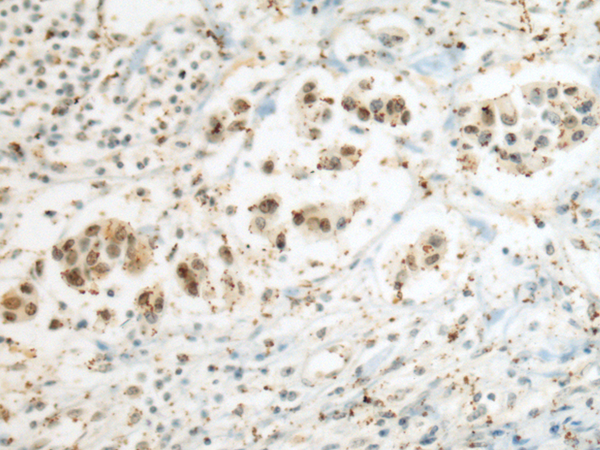
| WB | 咨询技术 | Human,Mouse,Rat |
| IF | 咨询技术 | Human,Mouse,Rat |
| IHC | 1/50-1/200 | Human,Mouse,Rat |
| ICC | 技术咨询 | Human,Mouse,Rat |
| FCM | 咨询技术 | Human,Mouse,Rat |
| Elisa | 1/5000-1/10000 | Human,Mouse,Rat |
| Aliases | SPS; SELD; SPS1 |
| Host/Isotype | Rabbit IgG |
| Antibody Type | Primary antibody |
| Storage | Store at 4°C short term. Aliquot and store at -20°C long term. Avoid freeze/thaw cycles. |
| Species Reactivity | Human, Mouse |
| Immunogen | Fusion protein of human SEPHS1 |
| Formulation | Purified antibody in PBS with 0.05% sodium azide and 50% glycerol. |
+ +
以下是关于SEPHS1抗体的3篇参考文献示例(内容基于公开研究整理,仅供参考):
---
1. **文献名称**:*Selenophosphate synthetase 1 (SEPHS1) is essential for cancer cell survival under oxidative stress*
**作者**:Carlsson L, et al.
**摘要**:该研究通过使用特异性SEPHS1抗体,验证了SEPHS1在乳腺癌细胞中的高表达,并证明其通过调控硒代谢途径帮助肿瘤细胞抵抗氧化应激。抗体应用于Western blot和免疫荧光实验,确认了SEPHS1在细胞质中的定位。
2. **文献名称**:*SEPHS1 deficiency disrupts selenocysteine biosynthesis and leads to early embryonic lethality*
**作者**:Xu X, et al.
**摘要**:研究利用SEPHS1敲除小鼠模型及抗体检测,发现SEPHS1缺失导致硒代半胱氨酸合成障碍,引发胚胎致死。抗体在组织切片中的免疫组化结果显示SEPHS1在胚胎发育早期的广泛表达。
3. **文献名称**:*Targeting selenoprotein biosynthesis in neuroblastoma via SEPHS1 inhibition*
**作者**:Prabhu KS, et al.
**摘要**:该文献通过SEPHS1抗体进行蛋白质表达分析,揭示了抑制SEPHS1可阻断神经母细胞瘤的生长。研究还利用抗体验证了SEPHS1与肿瘤代谢重编程的相关性,提示其作为潜在治疗靶点。
---
如需获取具体文献全文,建议通过PubMed或Sci-Hub等平台检索标题或作者。注意文献年份可能影响研究结论的时效性。
The SEPHS1 antibody is a tool used to detect Selenophosphate Synthetase 1 (SEPHS1), a key enzyme involved in selenium metabolism. SEPHS1 catalyzes the synthesis of selenophosphate, a critical substrate for the incorporation of selenocysteine into selenoproteins. These proteins, such as glutathione peroxidases and thioredoxin reductases, play vital roles in antioxidant defense, redox signaling, and thyroid hormone metabolism. Dysregulation of SEPHS1 is linked to oxidative stress-related diseases, including cancer, neurodegenerative disorders, and cardiovascular conditions.
The antibody is commonly used in research to study SEPHS1 expression, localization, and function in cellular and tissue contexts. It aids in identifying changes in SEPHS1 levels under pathological conditions, such as tumor progression, where altered selenium metabolism may promote survival or drug resistance in cancer cells. Applications include Western blotting, immunohistochemistry, and immunofluorescence to analyze protein expression patterns in clinical or experimental samples.
Developed in hosts like rabbit or mouse, SEPHS1 antibodies are validated for specificity and sensitivity, often targeting unique epitopes within the protein. Their utility extends to mechanistic studies, such as exploring SEPHS1's role in selenium-dependent pathways or validating CRISPR/Cas9 knockout models. Researchers also leverage these antibodies to investigate therapeutic targeting of selenium metabolism in diseases, emphasizing their importance in both basic and translational biomedical research.
×